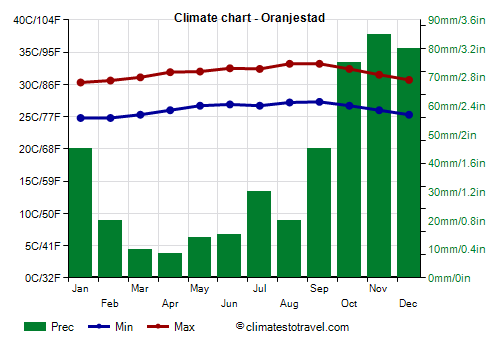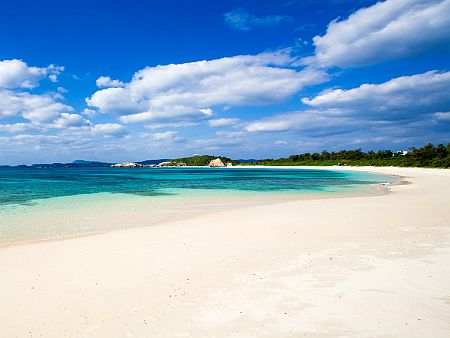Select units of measurement for the temperature and rainfall tables (metric or imperial).
Average weather, temperature, rainfall, sunshine
In Aruba, the climate is
tropical semi-arid, hot all year round: daytime temperatures hover around 30/33 degrees Celsius (86/91 °F) throughout the year; the air is muggy, but the wind tempers the heat.
From February to August, the
south-east trade winds blow, which come from South America and bring dry weather, while from October to January, is the period of the
north-east trade winds, which are a little less intense and can sometimes bring rain.
The trade winds blow constantly, and the east coast is affected by strong sea currents, while the western and southern coasts are more sheltered, and made of sandy beaches. The wind is more intense from February to August, in the driest period, and less intense in October and November.
Aruba is a constituent part of the Netherlands, located in the Caribbean Sea at 12 degrees north latitude, about 30 km (18 miles) north of the Paraguaná peninsula, which belongs to Venezuela. Together with
Curaçao,
Bonaire and some islands of Venezuela, it is catalogued among the
Leeward Antilles, namely, those islands that have an arid climate in comparison with the rest of the Caribbean, as evidenced by the vegetation consisting mainly of shrubs and cacti. The three islands that once belonged to the Netherlands Antilles (Aruba, Curaçao and Bonaire) are sometimes called ABC Islands.
Aruba is a flat island, and owing to the scarcity of rain water and streams, the water is desalinated from the sea.
The climate in detail
Temperature and rain
Oranjestad

In the capital,
Oranjestad, the average temperature fluctuates between around 27.5 °C (81.5 °F) in January and February, and 30 °C (86 °F) in August and September.
Precipitation is scarce, in fact, it amounts to around 450 millimeters (17.7 inches) per year. The only fairly rainy period is from October to December, when 75/85 mm (2.9/3.3 in) or rain fall per month. As mentioned, this happens because of the north-east trade winds, which can cause rain showers quite frequently also in January and sometimes in the first half of February.
The
sunshine amount is good in all seasons, so much so that there are over 3,000 hours of sunshine per year.

Sea temperature
The
sea in Aruba is warm enough to swim in throughout the year: the water temperature ranges from 26 °C (79 °F) in the January-March period to 28.5 °C (83.5 °F) from September to November.
Hurricanes
From June to November, but especially from August to October, there is the danger of tropical storms and
hurricanes, which, however, are rare at these latitudes, in fact, Aruba is located at the southern edge of the hurricane belt. Anyway, it's not impossible that hurricanes could hit Aruba, as happened with Hurricane Irene in September 1971, Joan in October 1988, Bret (tropical storm) in August 1993, Ivan in September 2004, Felix in September 2007, and Omar in October 2008.
When to go
Having a hot climate with little rain, the island of Aruba can be visited all year round. However, the best time is
from mid-February to late May, being the driest of the year and outside of the hurricane season. During this period, temperatures gradually rise.
Summer, from June to September, is the hottest period, although the trade winds make the heat more bearable. The weather is almost always good even in this season, but there may be some showers, usually of short duration.
In the October-December period, there is moderate rainfall, although generally not excessive; sometimes, this relatively rainy period continues until the month of January or the first half of February.
The period from August to December can be avoided, because from August to October there is the risk (albeit low) of hurricanes, while from September to December it is the rainiest period of the year.
What to pack
All year round: bring tropics-friendly,
light clothes made of cotton or linen, and possibly a light raincoat for thunderstorms, especially from October to January. Those who are sensitive to cold can bring a light sweatshirt for the evening.
When going to the reef, you can bring snorkeling equipment, including water shoes or rubber-soled shoes.
Climate data - Aruba
| Oranjestad |
|---|
|
| Jan | Feb | Mar | Apr | May | Jun | Jul | Aug | Sep | Oct | Nov | Dec |
|---|
| Min temp. | 25 | 25 | 25 | 26 | 27 | 27 | 27 | 27 | 27 | 27 | 26 | 25 |
|---|
| Max temp. | 30 | 31 | 31 | 32 | 32 | 32 | 32 | 33 | 33 | 32 | 32 | 31 |
|---|
| Precip. | 45 | 20 | 10 | 10 | 15 | 15 | 30 | 20 | 45 | 75 | 85 | 80 |
|---|
| Prec. days | 11 | 4 | 2 | 2 | 2 | 3 | 4 | 3 | 3 | 7 | 10 | 11 |
|---|
| Humidity | 77% | 75% | 75% | 76% | 77% | 76% | 77% | 75% | 75% | 77% | 78% | 77% |
|---|
| Day length | 12 | 12 | 12 | 12 | 13 | 13 | 13 | 12 | 12 | 12 | 12 | 11 |
|---|
| Sun hours | 8 | 8 | 8 | 8 | 8 | 9 | 10 | 9 | 9 | 8 | 8 | 7 |
|---|
| Sea temp | 26 | 26 | 26 | 27 | 27 | 28 | 27 | 28 | 29 | 29 | 28 | 27 |
|---|